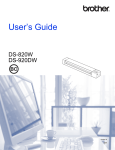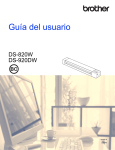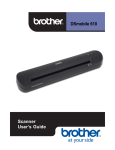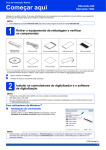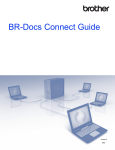Download Brother DS-920DW Setup guide
Transcript
Quick Setup Guide Start Here DSmobile 820W DSmobile 920DW Thank you for choosing Brother. Your support is important to us and we value your business. Before using your machine, read this Quick Setup Guide for the correct setup and installation. NOTE • For DSmobile 920DW users: this guide uses DSmobile 820W screen images. 1 Unpack the machine and check the components DSmobile 820W or DSmobile 920DW Carrier Sheet Li-ion Battery Micro USB Cable SD Memory Card Quick Setup Guide DVD-ROM Calibration Sheet Product Registration Sheet Warranty Card Cleaning Cloth Soft Carrying Bag * If your computer does not have a DVD-ROM drive, the supplied DVD-ROM does not contain drivers for your operating system, or you want to download manuals and utilities, visit your model page at http://solutions.brother.com/. a b a Remove the packing material. Make sure you have all the components. 2 Before you use the scanner Install the supplied Li-ion Battery into the end of your scanner, as shown in the illustration. NOTE • When charging the battery, press and hold the Power button to turn off your scanner. You can charge the battery with the power either on or off, but charging takes more time than when the scanner is off. • (DSmobile 820W) • When charging the battery with the power on, slide the Wi-Fi® switch to OFF. When the scanner is turned on, the battery level is displayed on the LCD panel. Battery icon Power level Full Half full Low (DSmobile 920DW) • • d b c Make sure that your computer is ON. If you do not use the scanner for a long period, charge the battery fully at least once every six months to prevent battery capacity and store the battery in a cool, dry place at a consistent temperature. If you do not use the scanner for a long period, remove the battery from the scanner. Gently insert the supplied SD Memory Card into the memory card slot on your scanner. (DSmobile 820W) (DSmobile 920DW) Connect the supplied Micro USB Cable to the micro USB port on your scanner. Connect the cable to your computer. The battery starts charging automatically. The Power button lights up green while the battery is charging, and goes off when charging is complete. USA Version A 1 3 Scan a document to the memory card NOTE • a b c d e f To scan a document using your computer (TWAIN Mode), you must install scanner drivers and software (see step 5) and connect your computer to the scanner (see Connecting your scanner to your computer in TWAIN Mode in the User’s Guide). Browse for scanned images on your scanner’s memory card a b Make sure that the SD Memory Card is in the scanner’s memory card slot. Press the Power button to turn on your scanner. a Make sure that SD appears on the scanner’s LCD panel. Insert your document, face up, into the feeder slot. Align the document with the left edge b of the feeder slot. Slide the document guide c until it touches the right side of the document. For DSmobile 920DW: When you perform duplex scanning, insert the first page face up into the feeder slot. Gently push the document until you feel its top edge touch the inside of the scanner. Scanning begins automatically. The scanned image will be saved on the SD Memory Card. 4 Browse scanned images using a wireless network • You can also view scanned images stored on the memory card by inserting the memory card directly into your computer’s memory card slot (if applicable). • After viewing the scanned data, slide the Wi-Fi® switch to OFF to save the battery. View scanned images using AndroidTM / iOS To use ScanHubTM for browsing or downloading images from your scanner, install the application from Google Play (AndroidTM) or the App Store (iOS) onto your wireless equipment (computer, smartphone, tablet, etc.). NOTE • If you have not set a Wi-Fi® network password, be sure to set up a network password in your web browser first. For more information on setting password, see Setting Without a Wi-Fi® network password, data on your SD card can be viewed and stolen by a third party. Locate the scanner on your wireless network a b • c 2 Brother Online can provide you the document management service for your scanned images. For more information, visit to check http://www.brother.com/product/brotheronline/. 5 ® On your wireless device, select your scanner’s SSID, Brother DS-820W-xxxx (Brother DS-920DW-xxxx). (where xxxx = your scanner’s Media Access Control (MAC) address) Without a Wi-Fi® network password, data on your SD card can be viewed and stolen by a third party. Storage service on Brother Online Slide the Wi-Fi® switch on the end of your scanner to ON. Wait for about 40 seconds, until the Wi-Fi® LED turns from red to blue. Activate the Wi-Fi function of your wireless equipment (computer, smartphone, tablet, etc.) so that it can search for your scanner. If you have not set a Wi-Fi® network password, be sure to set up a network password in your web browser first. For more information on setting password, see Setting Wi-Fi® network password in the User’s Guide. Wi-Fi® network password in the User’s Guide. • Launch a web browser on your wireless device and type http://10.10.100.1 (your scanner’s HTTP address) in the address bar. When you first view scanned images, the Password Setup screen will appear. Set a password and click Apply. If you have already set your password, log in by entering your password. Your scanner’s home page appears in the browser. When there are scanned images saved on the memory card, these images will appear in the home screen. NOTE NOTE • Make sure that the SD Memory Card is in the scanner’s memory card slot. Install scanner drivers and scanning software NOTE • • Make sure that your computer is ON and you are logged on with Administrator rights. If your computer does not have a DVD-ROM drive, download the scanner driver from Brother Solutions Center at http://solutions.brother.com/. For Windows® users a Driver installation For Macintosh users a Driver installation Insert the DVD-ROM. Double-click the DVD icon, and then doubleclick the DS-820W (DS-920DW) folder to open it. Double-click Brother DS-820W (DS920DW), and follow the on-screen instructions. Insert the DVD-ROM. When the Top Menu appears, click Install Scanner Driver and follow the on-screen instructions. NOTE • When you install the scanner driver, DSmobileCapture (a scanning application) will be installed at the same time. For more information on using DSmobileCapture, see Using NOTE • DSmobileCapture (for Windows®) in the User’s Guide. b Software installation Click Additional Applications on the Top Menu, and then you can install these applications: • Button Manager V2: document browsing and storing • PaperPortTM 12SE: document scanning, editing and management • Presto! BizCard 6: business card scanning, editing and management • BR-Receipts: receipt scanning, editing and management b • For more information on which scanning application will work best for you, see Choosing your scanning software in the User’s Guide. To register your product and download BR-Receipts, click Download BR-Receipts to access the Brother Online site at http://www.brother.com/product/brotheronline/. Software installation You can install these applications during the setup: • Presto! PageManager 9: document scanning, editing and management • Presto! BizCard 6: business card scanning, editing and management • BR-Receipts: receipt scanning, editing and management NOTE • • NOTE • When you install the scanner driver, DSmobileCapture (a scanning application) will be installed at the same time. For more information on using DSmobileCapture, see Using DSmobileCapture (for Macintosh) in the User’s Guide. • For more information on which scanning application will work best for you, see Choosing your scanning software in the User’s Guide. Double-clicking Presto! PageManager or Presto! BizCard will bring you to NewSoft Technology Corporation’s website. Download the application from this website. To register your product and download BR-Receipts (available for purchase), double-click BR-Receipts to access the Brother Online site at http://www.brother.com/product/brotheronline/. 3 6 User’s Guide and FAQs Product Safety Guide Symbols and conventions used in this documentation This machine’s User’s Guide is located on the supplied DVD-ROM. If your computer does not have a DVD-ROM drive, you can download manuals by visiting your model page at http://solutions.brother.com/. For Windows® users Insert the DVD-ROM. When the Top Menu appears, click User’s Guides. For Macintosh users Insert the DVD-ROM. Double-click the DVD icon, and then doubleclick DS-820W (DS-920DW). Double-click Documentation, and then launch your language folder. DANGER DANGER indicates an imminently hazardous situation which, if the product is handled without following the warnings and instructions, will result in death or serious injuries. WARNING WARNING indicates a potentially hazardous situation which, if not avoided, could result in death or serious injuries. CAUTION CAUTION indicates a potentially hazardous situation which, if not avoided, may result in minor or moderate injuries. IMPORTANT FAQs Hazard notice: “Be careful.” For FAQs (Frequently Asked Questions), Product Support and Technical Questions, Driver Updates and Utilities, and User’s Guides, go to your model page at: http://solutions.brother.com/. Trademarks The Brother logo is a registered trademark of Brother Industries, Ltd. Brother is a registered trademark of Brother Industries, Ltd. Windows is registered trademark of Microsoft Corporation in the United States and/or other countries. Macintosh, iOS and App Store are trademarks of Apple Inc., registered in the U.S. and other countries. Wi-Fi is a registered trademark of the Wi-Fi Alliance. Google Play and Android are trademarks of Google Inc. Any trade names and product names of companies appearing on Brother products, related documents and any other materials are all trademarks or registered trademarks of those respective companies. Compilation and Publication Under the supervision of Brother Industries, Ltd., this manual has been compiled and published, covering the latest product descriptions and specifications. The contents of this manual and the specifications of this product are subject to change without notice. Brother reserves the right to make changes without notice in the specifications and materials contained herein and shall not be responsible for any damages (including consequential) caused by reliance on the materials presented, including but not limited to typographical and other errors relating to the publication. Copyright and License ©2013 Brother Industries, Ltd. All rights reserved. Important indicates a potentially hazardous situation which, if not avoided, may result in damage to property or loss of product function. Restricted conduct. Proper conduct: “What you have to do.” Risk of fire under certain circumstances. DANGER Use the rechargeable battery only for its intended purpose. The scanner and rechargeable battery are designed to function exclusively with each other. Do not insert a different rechargeable battery into the scanner or insert the rechargeable battery into a different scanner, otherwise fire or damage may result. To charge the rechargeable battery, insert the rechargeable battery into the scanner, and connect your scanner with your computer using the supplied Micro USB cable. DO NOT charge the rechargeable battery near a fire or in direct sunlight. This could activate the protection circuitry, which is designed to prevent danger from high heat. Activation of the protection circuitry could cause charging to stop, charging to occur with excessive current or voltage if the protection circuitry fails, or an abnormal chemical reaction within the battery. DO NOT allow wires or other metal objects to come into contact with the terminals of the rechargeable battery. Do not carry or store the rechargeable battery with metal objects such as necklaces or hairpins. This could cause an electrical short, and could cause metal objects to overheat, such as wires, necklaces, or hairpins to overheat. DO NOT use or leave the rechargeable battery near fire, heaters, or other high temperature (above 176°F/80°C) locations. DO NOT allow the rechargeable battery to come into contact with or to be immersed in water. DO NOT use in corrosive environments, such as areas where salty air, salt water, acids, alkalis, corrosive gases, chemicals, or any corrosive liquid are present. DO NOT use the rechargeable battery if it is damaged or leaking. DO NOT directly solder any connections to the rechargeable battery. This could cause internal insulation to melt, gas to be emitted, or safety mechanisms to fail. 4 DANGER WARNING DO NOT use the rechargeable battery with the polarity (+) (-) reversed. Check the orientation of the rechargeable battery before inserting it, and do not try to force the rechargeable battery into the scanner. Charging the rechargeable battery with the polarity reversed could cause an abnormal chemical reaction within the rechargeable battery or abnormal current flow during discharge. Do not spill drinks, i.e. coffee, juice, etc., or water on the device. Do not use the device in places where water may splash the device. This may result in igniting a fire, electric shock, or device failure. In such a event turn the power switch off immediately, remove the USB cable from the outlet. Contact the store where this unit was purchased. DO NOT directly connect the rechargeable battery to a household electrical supply. Liquid (electrolyte) leaking from the scanner or rechargeable battery may indicate that the rechargeable battery is damaged. If the rechargeable battery leaks, immediately discontinue use of the scanner, unplug the cable, and isolate the scanner by putting it in a bag. Do not touch the electrolyte. If electrolyte gets in the eyes, do not rub the eyes. Immediately rinse liberally with tap water or other clean water and seek the advice of a medical professional. If left alone, the electrolyte could cause eye damage. If electrolyte contacts your skin or clothing, immediately rinse them with water. DO NOT put the rechargeable battery, or a scanner with the rechargeable battery installed, into a microwave oven or a high pressure container. DO NOT leave the rechargeable battery with out of power in the main unit for a long period of time. This could shorten the life of the rechargeable battery or lead to an electrical short. If the scanner can only be used for a short period of time, even though the rechargeable battery is fully charged, the rechargeable battery may have reached the end of its service life. Replace the rechargeable battery with a new one. When removing and replacing the rechargeable battery, cover the terminals of the old rechargeable battery with tape to avoid creating a short in the battery. DO NOT disassemble, modify, or attempt to repair the rechargeable battery. DO NOT dispose of the rechargeable battery in fire or intentionally overheat. This could cause the internal insulation to melt, gas to be emitted, or safety mechanisms to fail. Additionally, the electrolyte solution could catch fire. DO NOT puncture the rechargeable battery with any objects, subject it to severe shocks or throw it. Damage to the rechargeable battery's protection circuit could cause the rechargeable battery to be recharged at an abnormal current/voltage or cause an abnormal chemical reaction within the rechargeable battery. DO NOT incinerate the rechargeable battery or dispose of it with household waste. WARNING Store the USB cable bundled out of the reach of children to avoid the risk of injury. Do not disassemble or modify the unit. This may result in a fire, electric shock, or device failure. Contact the store where this unit was purchased to inspect, adjust, and repair the internal components of the unit. (There will be a charge for repairs even when conducted within the warranty period if the unit fails due to the disassembly or modifications by the customer.) Keep plastic bags bundled out of the reach of children or throw them away to avoid the danger of suffocation. Do not place near open flames or heater. This may result in a fire or device failure. CAUTION Strong jolts, i.e. drop, being stepped on, etc., may damage the unit. This may result in injury. In the event that the unit is damaged, turn the power switch off immediately, remove the USB cable from the outlet. Contact the store where this unit was purchased. RISK OF EXPLOSION IF BATTERY IS REPLACED BY AN INCORRECT TYPE. DISPOSE OF USED BATTERIES ACCORDING TO THE INSTRUCTIONS. Do not locate the device on rackety or aslope tables. Do not locate the device on unstable surface. The device may fall down and this may result in injury. Do not place heavy objects on the unit. It may cause unbalance and the device may fall down. This may result in injury. Do not use an organic solvent, i.e. flammable gas, alcohol, etc., when cleaning the device. Do not use them near the device. This may result in a fire or device failure. Be cautious when you handle paper. Edges of paper may cut your hands. IMPORTANT Do not leave the device at places exposed to direct sunlight and places near open flames or heater with extremely high or low temperature. Do not use and store the device in locations of much humidity and dust. Do not conduct any operations not instructed in this guide. This may result in injury or device failure. Do not use an organic solvents, i.e. paint thinner, benzene, alcohol, etc., when cleaning the unit. This may damage the finish on the surface or may peel the paint resulting in damage. Wipe away any dirt on the unit using a soft, dry cloth. Do not use any USB cables except the USB cable bundled. Do not use the device in locations where temperature changes are extreme. The resulting condensation may result in device failure or malfunction. In the event of condensation, use only after drying the device naturally. Do not use the device in abnormal conditions, i.e. appearance of smoke, strange smell, odd noise, etc. This may result in a fire, burns, or device failure. Turn the power switch off immediately, remove the USB cable from the outlet. Contact the store where this unit was purchased. In the event that foreign material enters the unit, turn the power switch off immediately, remove the USB cable. Contact the store where this unit was purchased. This may result in a fire, electric shock, or device failure. 5 Surroundings temperature range ATTENTION: The Li-ion battery you have purchased is recyclable. At the end of its useful life, under various state and local laws, it is illegal to dispose of this battery into your municipal waste stream. Please call 1-800-8-BATTERY Rechargeable Li-ion battery • At the time of purchase, the rechargeable Li-ion battery is slightly charged so that the operation of the scanner can be verified; however, the rechargeable Li-ion battery should be fully charged via the USB port before the scanner is used. • If the scanner will not be used for a long period of time, remove the rechargeable Li-ion battery from the scanner, and then store it in a location where it is not exposed to static electricity, high humidity, or high temperatures (temperatures between 59°F/15°C and 77°F/25°C and 40% to 60% humidity are recommended). In order to maintain the efficiency and life of the Li-ion rechargeable battery, charge it at least every six months. • If you notice anything unusual about the rechargeable Li-ion battery the first time it is used, for example overheating or rust, DO NOT continue to use the battery. Contact Brother customer service. Tips on using the rechargeable Li-ion battery • Charge the rechargeable Li-ion battery before use. Do not use it before it is charged. • The rechargeable Li-ion battery charging can take place in 41°F-95°F (5°C-35°C) environments. Charge the rechargeable Li-ion battery in an environment in this temperature range. If the surrounding temperature is out of this range, the rechargeable Li-ion battery will not be charged, and the battery indicator will remain lit. • If the scanner is used when both the rechargeable Li-ion battery is installed and the scanner is connected to your computer, the battery indicator may turn off and charging may stop even if the rechargeable Li-ion battery has not been fully charged. Rechargeable Li-ion battery characteristics Understanding the properties of the rechargeable Li-ion battery will allow you to optimize its usage. • Using or storing the rechargeable Li-ion battery in a location exposed to high or low temperatures may accelerate its deterioration. In particular, using a rechargeable Li-ion battery with a high charge (90% or more) in a location exposed to high temperatures will considerably accelerate battery deterioration. • Using the scanner while the rechargeable Li-ion battery is installed and charging may accelerate the battery’s deterioration. If using the scanner when the rechargeable Li-ion battery is installed, disconnect the USB cable. • If the scanner will not be used for longer than one month, remove the rechargeable Li-ion battery from the scanner when its charge is 50% or less, and then store the battery in a cool place away from direct sunlight. • If the rechargeable Li-ion battery will not be used for a long period of time, we recommend charging it every 6 months. • If you touch a part of the scanner while the Li-ion battery is charging, that part of the scanner may feel warm. This is normal, and the scanner may be used safely. If the scanner becomes extremely hot, discontinue use. www.brotherearth.com 6 Charge 32 °F – 113 °F (0 °C – 45 °C) Standard discharge current 0.36 A -4 °F – 140 °F (-20 °C – 60 °C) Maximum discharge current 1.7 A -4 °F – 140 °F (-20 °C – 60 °C) Shipped battery Less than 1 month -4 °F – 131 °F (-20 °C – 55 °C) Less than 3 month 14 °F – 113 °F (-10 °C – 45 °C) Less than 1 year 32 °F – 77 °F (0 °C – 25 °C) Charging parameters Maximum charging voltage 4.2 Vdc Maximum charging current 1700 mA Federal Communications Commission (FCC) Declaration of Conformity (USA only) Responsible Party: Brother International Corporation 200 Crossing Boulevard Bridgewater, NJ 08807-0911 USA TEL: (908) 704-1700 declares, that the products Product Name: DSmobile 820W / DSmobile 920DW Model Numbers: DS-820W / DS-920DW comply with Part 15 of the FCC Rules. Operation is subject to the following two conditions: (1) This device may not cause harmful interference, and (2) this device must accept any interference received, including interference that may cause undesired operation. This equipment has been tested and found to comply with the limits for a Class B digital device, pursuant to Part 15 of the FCC Rules. These limits are designed to provide reasonable protection against harmful interference in a residential installation. This equipment generates, uses, and can radiate radio frequency energy and, if not installed and used in accordance with the instructions, may cause harmful interference to radio communications. However, there is no guarantee that interference will not occur in a particular installation. If this equipment does cause harmful interference to radio or television reception, which can be determined by turning the equipment off and on, the user is encouraged to try to correct the interference by one or more of the following measures: Reorient or relocate the receiving antenna. Increase the separation between the equipment and receiver. Connect the equipment into an outlet on a circuit different from that to which the receiver is connected. Call the dealer or an experienced radio/TV technician for help. This transmitter must not be co-located or operated in conjunction with any other antenna or transmitter. IMPORTANT • • Changes or modifications not expressly approved by Brother Industries, Ltd. could void the user’s authority to operate the equipment. A shielded interface cable should be used to ensure compliance with the limits for a Class B digital device. The equipment complies with FCC RF radiation exposure limits set forth for an uncontrolled environment, under 47 CFR 2.1093 paragraph (d)(2). The equipment has been tested to the FCC exposure requirements (Specific Absorption Rate).






